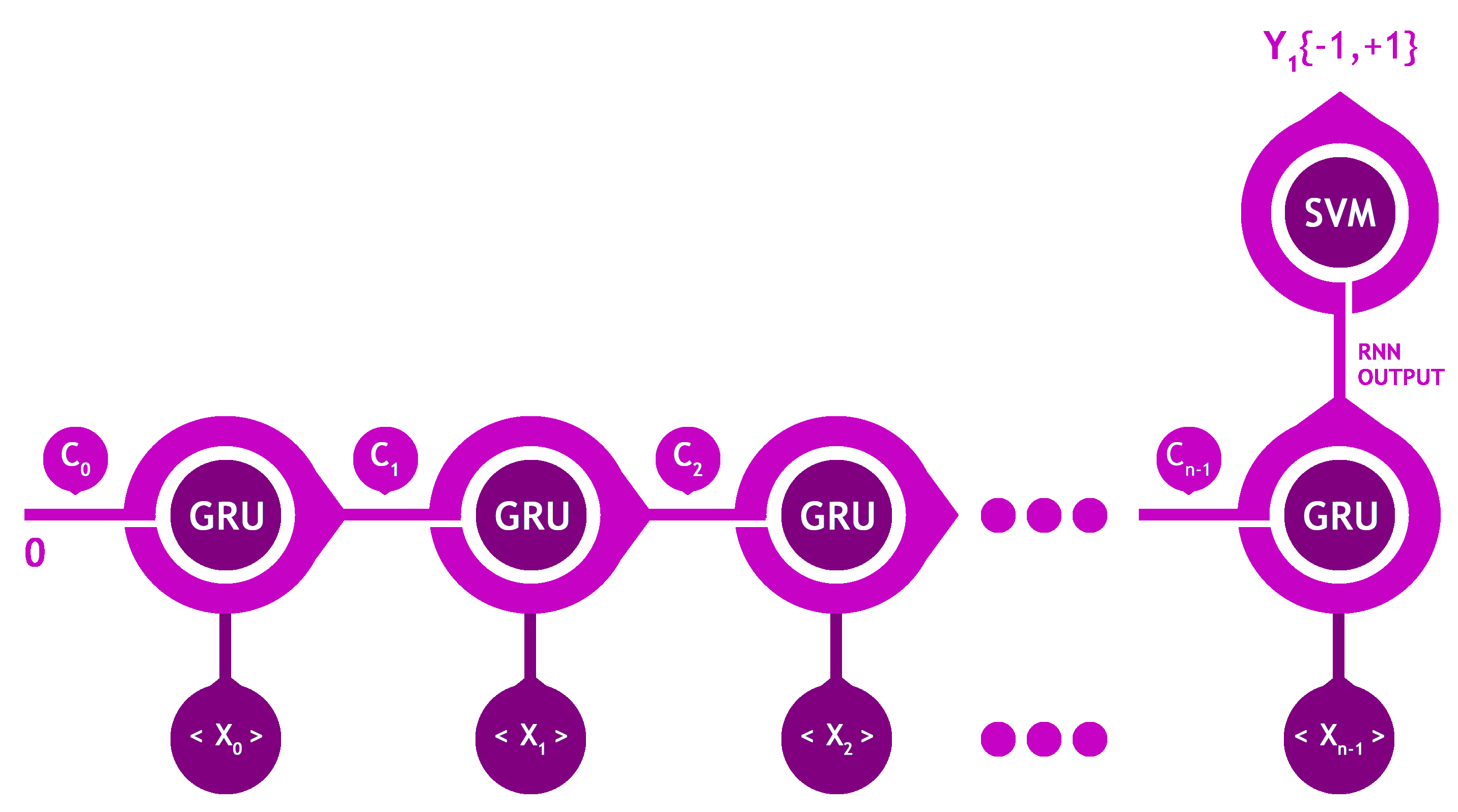AFAgarap / Gru Svm
Programming Languages
Labels
Projects that are alternatives of or similar to Gru Svm
A Neural Network Architecture Combining Gated Recurrent Unit (GRU) and Support Vector Machine (SVM) for Intrusion Detection
This is an accepted paper at the 10th International Conference on Machine Learning and Computing (ICMLC) in Macau, China on February 26-28, 2018.
The full paper on this project may be read at arXiv.org.
Illustration by Andreina Mariella A. Miling. The proposed neural network architecture combines the gated recurrent unit (GRU) variant of recurrent neural network (RNN) and the linear support vector machine (SVM). The SVM is then used as the classifier of the neural network.
Abstract
Gated Recurrent Unit (GRU) is a recently-developed variation of the long short-term memory (LSTM) unit, both of which are variants of recurrent neural network (RNN). Through empirical evidence, both models have been proven to be effective in a wide variety of machine learning tasks such as natural language processing (Wen et al., 2015), speech recognition (Chorowski et al., 2015), and text classification (Yang et al., 2016). Conventionally, like most neural networks, both of the aforementioned RNN variants employ the Softmax function as its final output layer for its prediction, and the cross-entropy function for computing its loss. In this paper, we present an amendment to this norm by introducing linear support vector machine (SVM) as the replacement for Softmax in the final output layer of a GRU model. Furthermore, the cross-entropy function shall be replaced with a margin-based function. While there have been similar studies (Alalshekmubarak & Smith, 2013; Tang, 2013), this proposal is primarily intended for binary classification on intrusion detection using the 2013 network traffic data from the honeypot systems of Kyoto University. Results show that the GRU-SVM model performs relatively higher than the conventional GRU-Softmax model. The proposed model reached a training accuracy of ~81.54% and a testing accuracy of ~84.15%, while the latter was able to reach a training accuracy of ~63.07% and a testing accuracy of ~70.75%. In addition, the juxtaposition of these two final output layers indicate that the SVM would outperform Softmax in prediction time - a theoretical implication which was supported by the actual training and testing time in the study.
Citation
To cite the paper, kindly use the following BibTex entry:
@inproceedings{agarap2018neural,
title={A Neural Network Architecture Combining Gated Recurrent Unit (GRU) and Support Vector Machine (SVM) for Intrusion Detection in Network Traffic Data},
author={Agarap, Abien Fred M},
booktitle={Proceedings of the 2018 10th International Conference on Machine Learning and Computing},
pages={26--30},
year={2018},
organization={ACM}
}
To cite the repository/software, kindly use the following BibTex entry:
@misc{abien_fred_agarap_2017_1045887,
author = {Abien Fred Agarap},
title = {AFAgarap/gru-svm v0.3.11-alpha},
month = nov,
year = 2017,
doi = {10.5281/zenodo.1045887},
url = {https://doi.org/10.5281/zenodo.1045887}
}
Usage
First, clone this repository:
git clone https://github.com/AFAgarap/gru-svm.git/
Then, install the required libraries:
sudo pip install -r requirements.txt
The following are the parameters for the module (gru_svm_main.py) implementing the GRU-SVM class found in gru-svm/models/gru_svm/gru_svm.py:
usage: gru_svm_main.py [-h] -o OPERATION [-t TRAIN_DATASET] -v
VALIDATION_DATASET -c CHECKPOINT_PATH [-l LOG_PATH]
[-m MODEL_NAME] -r RESULT_PATH
GRU+SVM for Intrusion Detection
optional arguments:
-h, --help show this help message and exit
Arguments:
-o OPERATION, --operation OPERATION
the operation to perform: "train" or "test"
-t TRAIN_DATASET, --train_dataset TRAIN_DATASET
the NumPy array training dataset (*.npy) to be used
-v VALIDATION_DATASET, --validation_dataset VALIDATION_DATASET
the NumPy array validation dataset (*.npy) to be used
-c CHECKPOINT_PATH, --checkpoint_path CHECKPOINT_PATH
path where to save the trained model
-l LOG_PATH, --log_path LOG_PATH
path where to save the TensorBoard logs
-m MODEL_NAME, --model_name MODEL_NAME
filename for the trained model
-r RESULT_PATH, --result_path RESULT_PATH
path where to save the actual and predicted labels
Then, use the sample data in gru-svm/dataset/train/train_data.npy for training the proposed GRU-SVM:
cd gru-svm
python3 gru_svm_main.py --operation "train" \
--train_dataset dataset/train/train_data.npy \
--validation_dataset dataset/test/test_data.npy \
--checkpoint_path models/checkpoint/gru_svm \
--model_name gru_svm.ckpt \
--log_path models/logs/gru_svm \
--result_path results/gru_svm
After training, the model can be used as follows:
python3 gru_svm_main.py --operation "test" \
--validation_dataset dataset/test/test_data.npy \
--checkpoint_path models/checkpoint/gru_svm \
--result_path results/gru_svm
Or simply use the prepared script files:
# Makes the script files executable
sudo chmod +x setup.sh
sudo chmod +x run.sh
# Installs the pre-requisite software and libraries
./setup.sh
# Runs the GRU-SVM for intrusion detection
./run.sh
Results
The results of the study may be found in gru-svm/results.
License
A Neural Network Architecture Combining Gated Recurrent Unit (GRU) and
Support Vector Machine (SVM) for Intrusion Detection in Network Traffic Data
Copyright (C) 2017 Abien Fred Agarap
This program is free software: you can redistribute it and/or modify
it under the terms of the GNU Affero General Public License as published
by the Free Software Foundation, either version 3 of the License, or
(at your option) any later version.
This program is distributed in the hope that it will be useful,
but WITHOUT ANY WARRANTY; without even the implied warranty of
MERCHANTABILITY or FITNESS FOR A PARTICULAR PURPOSE. See the
GNU Affero General Public License for more details.
You should have received a copy of the GNU Affero General Public License
along with this program. If not, see <http://www.gnu.org/licenses/>.



